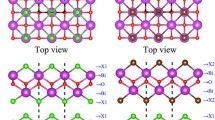Abstract
We have recently reported that the organic bilayer of 3,4,9,10-perylenetetracarboxyl-bisbenzimidazole (PTCBI, n-type semiconductor) and 29H,31H-phthalocyanine (H2Pc, p-type semiconductor), which is a part of a photovoltaic cell, acts as a photoanode in the water phase (Abe et al., ChemPhysChem 5:716, [2004]); in that case, the generation of the photocurrent involving an irreversible thiol oxidation at the H2Pc/water interface took place to be coupled with hole conduction through the H2Pc layer, based on the photophysical character of the bilayer. In the present work, the photoelectrode characteristics of the bilayer were investigated in the water phase containing a redox molecule \({\left( {{\text{Fe}}\,^{{{{\text{III}}} \mathord{\left/ {\vphantom {{{\text{III}}} {{\text{II}}}}} \right. \kern-\nulldelimiterspace} {{\text{II}}}}} {\left( {{\text{CN}}} \right)}^{{{3 - } \mathord{\left/ {\vphantom {{3 - } {4 - }}} \right. \kern-\nulldelimiterspace} {4 - }}}_{6} } \right)}\), where the photo-induced oxidation and reduction for the \({\text{Fe}}\,^{{{{\text{III}}} \mathord{\left/ {\vphantom {{{\text{III}}} {{\text{II}}}}} \right. \kern-\nulldelimiterspace} {{\text{II}}}}} {\left( {{\text{CN}}} \right)}^{{{3 - } \mathord{\left/ {\vphantom {{3 - } {4 - }}} \right. \kern-\nulldelimiterspace} {4 - }}}_{6}\) couple were found to take place at the bilayer. The photoanodic current involving the \({\text{Fe}}\,^{{{\text{II}}}} {\left( {{\text{CN}}} \right)}^{{4 - }}_{6}\) oxidation efficiently occurred at the interface of H2Pc/water, similar to the previous example. In the view of the voltammograms obtained, it was noted that there are pin-holes in the H2Pc layer of the bilayer, leading to a cathodic reaction with \({\text{Fe}}\,^{{{\text{III}}}} {\left( {{\text{CN}}} \right)}^{{3 - }}_{6}\) at the PTCBI surface especially in the dark; that is, the band bending at the PTCBI/water interface can essentially be reduced by applying a negative potential [e.g., < ∼ 0 V (vs Ag/AgCl)] to the PTCBI, when the cathodic reaction may take place through the conduction band of the PTCBI. Moreover, under that applied potential condition of irradiation, the photogenerated electron carrier part can move to the PTCBI surface, thus enhancing the reduction of \({\text{Fe}}\,^{{{\text{III}}}} {\left( {{\text{CN}}} \right)}^{{3 - }}_{6}\).









Similar content being viewed by others
References
Imahori H, Hosomizu K, Mori Y, Sato T, Ahn T-K, Kim S-K, Kim D, Nishimura Y, Yamazaki I, Ishii H, Hotta H, Matano Y (2004) J Phys Chem B 108:5018
Yang S, Fan L, Yang S (2004) J Phys Chem B 108:4394
Tang CW (1986) Appl Phys Lett 48:183
Morikawa T, Adachi C, Tsutsui T, Saito S (1990) Nippon Kagaku Kaishi 962
Hiramoto M, Fukusumi H, Yokoyama M (1992) Appl Phys Lett 61:2580
Wöhrle D, Kreienhoop L, Schnurpfeil G, Elbe J, Tennigkeit B, Hiller S, Schlettwein D (1995) J Mater Chem 5:1819
Abe T, Nagai K, Kaneko M, Okubo T, Sekimoto K, Tajiri A, Norimatsu T (2004) ChemPhysChem 5:716
Maki T, Hashimoto H (1952) Bull Chem Soc Jpn 25:411
Sharp JH, Lardon M (1968) J Phys Chem 72:3230
Surdhar S, Armstrong DA (1986) J Phys Chem 90:5915
Lever ABP, Milaeva ER, Speier G (1993) The redox chemistry of metallo-phthalocyanines in solution. In: Leznoff CC, Lever ABP (eds), Phthalocyanines, vol. 3. VCH, New York, pp 2–69
Zagal JH, Gulppi MA, Caro CA, Cárdenas-Jirón GI (1999) Electrochem Commun 1:389
Schlettwein D, Kaneko M, Yamada A, Wöhrle D, Jaeger NI (1991) J Phys Chem 95:1748
Hill IG, Kahn A (1999) J Appl Phys 86:2116
Stübinger T, Brütting W (2001) J Appl Phys 90:3632
Hiromitsu I, Murakami Y, Ito T (2003) J Appl Phys 94:2434
Yakimov A, Forrest SR (2002) Appl Phys Lett 80:1667
Hill IG, Schwartz J, Kahn A (2000) Org Electron 1:5
Loutfy RO, Cheng YC (1980) J Chem Phys 73:2902
Nagai K, Fujimoto Y, Shiroishi H, Kaneko M, Norimatsu T, Yamanaka T (2001) Chem Lett 354
Nagai K, Yoshida H, Norimatsu T, Miyanaga N, Izawa Y, Yamanaka T (2002) Appl Surf Sci 197:808
Acknowledgement
This work was partially supported by a Grant-in-Aid for Scientific Research (No. 15750110) from Ministry of Education, Culture, Sports, Science and Technology, Japan (T. A.).
Author information
Authors and Affiliations
Corresponding author
Rights and permissions
About this article
Cite this article
Abe, T., Nagai, K., Matsukawa, T. et al. Photoelectrode characteristics of an organic bilayer in water phase containing a redox molecule. J Solid State Electrochem 11, 303–309 (2007). https://doi.org/10.1007/s10008-006-0108-0
Received:
Accepted:
Published:
Issue Date:
DOI: https://doi.org/10.1007/s10008-006-0108-0



